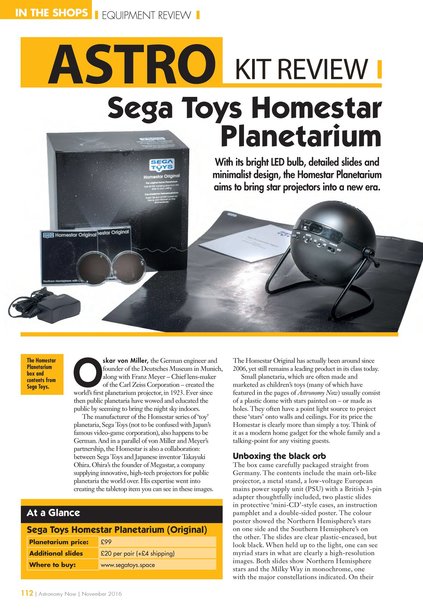Sega Toys Homestar in der Presse
23. Dezember 2016 Sweet (Vereinigte Staaten)
You Can Stargaze At Any Hour of the Day
Bring the beautiful night sky into your bedroom.
If you're longing to see more of what the night sky has to offer but live in a place where that just isn't possible on a regular basis, you may want to look into getting a home planetarium. There are many on the market, but the Homestar by Sega Toys—with its beautifully ornate renderings and sleek design—is the one that caught our eye.

22. Dezember 2016 Sweet (Vereinigte Staaten)
Turn Your Room Into the Great Indoors
All the fun of camping without even leaving the house.
A city kid since birth, I've learned to be more and more outdoorsy thanks to an annual weeklong camping trip that became a part of my life a few years ago. But after these yearly excursions are over, I'm left wondering: what the hell am I supposed to do for the next 51 weeks?
Improvise, that's what.
The other night, to celebrate my girlfriend's birthday, I tried an experiment: camping indoors. And we had a blast. Now, if an absurd adult take on fort-building doesn't sound up your alley, please feel free to move along. But if you like the thought of simulating the wonders of the great outdoors while still getting to laze about in the comfort of your heated home, here's everything you'll need to have the most transportive experience possible.
A Starry Sky
One of the highlights of camping for me is getting to spend hours staring at something I never see at home in New York City: a starry sky. But the weather is always a variable, so you can never be sure you won't end up sleeping under a cloud cover.At home? No such risk. There are a number of small projectors on the market that can instantly turn your blank ceiling into a star-filled night sky.
One of the highlights of camping for me is getting to spend hours staring at something I never see at home in New York City: a starry sky. But the weather is always a variable, so you can never be sure you won't end up sleeping under a cloud cover.
At home? No such risk. There are a number of small projectors on the market that can instantly turn your blank ceiling into a star-filled night sky.
Or go all in with the help of a projector.

1. November 2016 Astronomy Now (Vereinigtes Königreich)
Sega Toys Homestar Planetarium
With its bright LED bulb, detailed slides and minimalist design, the Homestar Planetarium aims to bring star projectors into a new era.
Oskar von Miller, the German engineer and founder of the Deutsches Museum in Munich, along with Franz Meyer – Chief lens-maker of the Carl Zeiss Corporation – created the world’s first planetarium projector, in 1923. Ever since then public planetaria have wowed and educated the public by seeming to bring the night sky indoors.
The manufacturer of the Homestar series of ‘toy’ planetaria, Sega Toys (not to be confused with Japan’s famous video-game corporation), also happens to be German. And in a parallel of von Miller and Meyer’s partnership, the Homestar is also a collaboration: between Sega Toys and Japanese inventor Takayuki Ohira. Ohira’s the founder of Megastar, a company supplying innovative, high-tech projectors for public planetaria the world over. His expertise went into creating the tabletop item you can see in these images. The Homestar Original has actually been around since 2006, yet still remains a leading product in its class today.
Small planetaria, which are often made and marketed as children’s toys (many of which have featured in the pages of Astronomy Now) usually consist of a plastic dome with stars painted on – or made as holes. They often have a point light source to project these ‘stars’ onto walls and ceilings. For its price the Homestar is clearly more than simply a toy. Think of it as a modern home gadget for the whole family and a talking-point for any visiting guests.
Unboxing the black orb
The box came carefully packaged straight from Germany. The contents include the main orb-like projector, a metal stand, a low-voltage European mains power supply unit (PSU) with a British 3-pin adapter thoughtfully included, two plastic slides in protective ‘mini-CD’-style cases, an instruction pamphlet and a double-sided poster. The colour poster showed the Northern Hemisphere’s stars on one side and the Southern Hemisphere’s on the other. The slides are clear plastic-encased, but look black. When held up to the light, one can see myriad stars in what are clearly a high-resolution images. Both slides show Northern Hemisphere stars and the Milky Way in monochrome, one with the major constellations indicated. On their website the company boasts that the Homestar will let you see 60,000 stars. For a small planetarium projector, that’s a lot.
Little-to-no assembly was required as the orb is cradled in its stand. It is simply a case of pointing the lens at the ceiling and tightening the two fasteners on either side to keep it in place. With its minimal, black, ‘Bauhaus-esque’ design, the Homestar is definitely designed for a modern living room or bedroom. But as it also resembles a mysterious, black eyeball, it wouldn’t look out of place in a 1970s science fiction film either.
Next to come out of the box was the low-voltage adapter. After untwisting ties and gently unravelling the cord it’s always a good idea to visually inspect the adapter, connector and the cord itself for any signs of damage. It’s also best to read the instructions – especially safety warnings – as they can show you how the device should behave (and what you should do if it doesn’t). Everything seemed fine and the device was plugged in as per the instructions. The Homestar doesn’t have a battery compartment or a rechargeable battery built in. Mains is the only power source. This may, in part, be due to available space, so as not to spoil the elegant design. It may also be because of the Homestar’s bright, three-watt LED lamp. A lithium-ion battery could power a bulb like this for a few hours, but store-bought ‘C’ or ‘D’ cells wouldn’t last long.
Using the Homestar
The brightness of toy planetaria in general tends to be limited by their single LEDs or ‘wheatgrain’ light bulbs. The reason for this is that illumination with a point-like light source provides sharp, clear images. But because the Homestar uses a lens to project its images, its three-watt bulb can be larger. And that means it is also much brighter.
The device has a pull-out tray on its side for slides. Once one is placed in, the tray is snapped into place and the planetarium switched on. The iris-like detail on the top isn’t aesthetic – it’s the focuser for the lens. By carefully rotating this ‘iris’ the stars above gradually come into sharp relief. The effect is breathtaking. For a small, home planetarium projector the Homestar is impressive. The combination of bright LED bulb, custom lens and detailed, high-contrast slides is what makes it so. Seeing the point-like stars of the Milky Way, the ones of the major constellations (portrayed as discs) and all of the other ‘field’ stars was hypnotic. The more one’s eyes adjust to the dark, the better the effect gets. And the Homestar has other functions too.
The projector doesn’t show entire slides in one go. It has a motor function that gently rotates a slide in such a way that all the stars come into view during a single rotation – a great way of adding functionality and interest. The rotation even works in two directions for both the Northern and Southern hemispheres. Although gentle, it’s quicker (and more noticeable) than the Earth’s own rotation. The motor’s really quiet too. The Homestar was demonstrated in front of friends who were suitably wowed (‘oohing’ at the detailed star-scape) and had a great time trying to spot constellations as they rotated into view.
There are two other features worth mentioning: the shooting star and the timer. Beside the Homestar’s main lens is a much smaller protrusion, looking a little bit like a clear LED. This projects a ‘shooting star’ streak over any projected slide and is made so it occurs at random somewhere, within a 30-second interval. Although a nice little effect (the other people in the room made ‘ooh’ sounds when they saw it), the reviewer thought it looked a little artificial. More useful however, was the timer function. This can be set to 15, 30 or 60 minutes, so one could fall asleep ‘under the stars’, safe in the knowledge that the device will shut itself off automatically – great for a child’s bedroom.
What of additional slides?
If you, your family or your guests find yourselves getting bored with the supplied slides, there are four additional ones for purchase on the Sega Toys website, which are sold as pairs. One pair contains the Southern Hemisphere stars (naturally) in monochrome and an impressively-detailed false-colour image of the Andromeda Galaxy. The other pair contains one slide showing the Earth and Moon within a – presumably fisheye – view of the Milky Way, with a similar one showing the Earth at night and the Moon’s far-side. Both of these are in colour. The slide pairs are discounted if bought together, or further if purchased with the Homestar unit itself. This seems a little poorly worded on the website. In conclusion, the Sega Toys Homestar Planetarium projector is well-designed both functionally and aesthetically. The available slides are based on high-quality data from actual space missions. It may be a bit expensive for some, but there’s no denying that it is a great little device – perfect for any living room or bedroom.

1. November 2016 Ke Next (Deutschland)
Geschenkideen für Konstrukteure und Ingenieure
Erinnerungen an die eigene Kindheit werden wahr, wenn man in die Sterne guckt. Aber wer will im tiefsten Winter schon draußen in der Kälte liegen und auf wolkenlose Nächte hoffen? Die Lösung bietet Sega Toys mit dem Homestar, ein Planetarium to go. Anschalten, sich gemütlich hinlegen und in die Sterne schauen. Und wer was lernen will, kann sich Sternbilder anzeigen lassen. Romantisch wird es, wenn der Zufallsgenerator dann noch ein paar Sternschnuppen generiert. Sterneschauen mit dem Homestar.

14. September 2016 Heimplanetarium.info (Deutschland)
Der große Heimplanetarium Test
Platz 1: Heimplanetarium Homestar Pro / Star Theatre von Sega Toys
Das beste Heimplanetarium aus unserer Sicht und damit auch Platz 1 in unserem Test ist das Homestar Pro / Star Theatre von Sega Toys. Auch wenn es uns nicht unbedingt durch seinen Preis von rund 100€ (Stand 06.06.2016) überzeugt hat, bietet es eine Menge anderer Vorzüge im Gegensatz zur Konkurrenz. So werden ganze 60.000 Sterne auf einmal an die Zimmerdecke geworfen, der Rotations-Motor gibt nicht allzu viele Geräusche von sich und auch die Materialqualität ist erste Sahne. Die zwei Sternen-Discs im Lieferumfang versprechen stundenlange, spannende Beobachtungen. Wenn selbst diese nicht ausreichen lässt sich das Homestar Pro / Star Theatre von Sega Toys mit zwei weiteren Karten problemlos aufrüsten.

1. Januar 2016 Vogue (Vereinigtes Königreich)

1. Januar 2016 GQ (Vereinigtes Königreich)

1. Januar 2016 Tatler (Vereinigtes Königreich)
